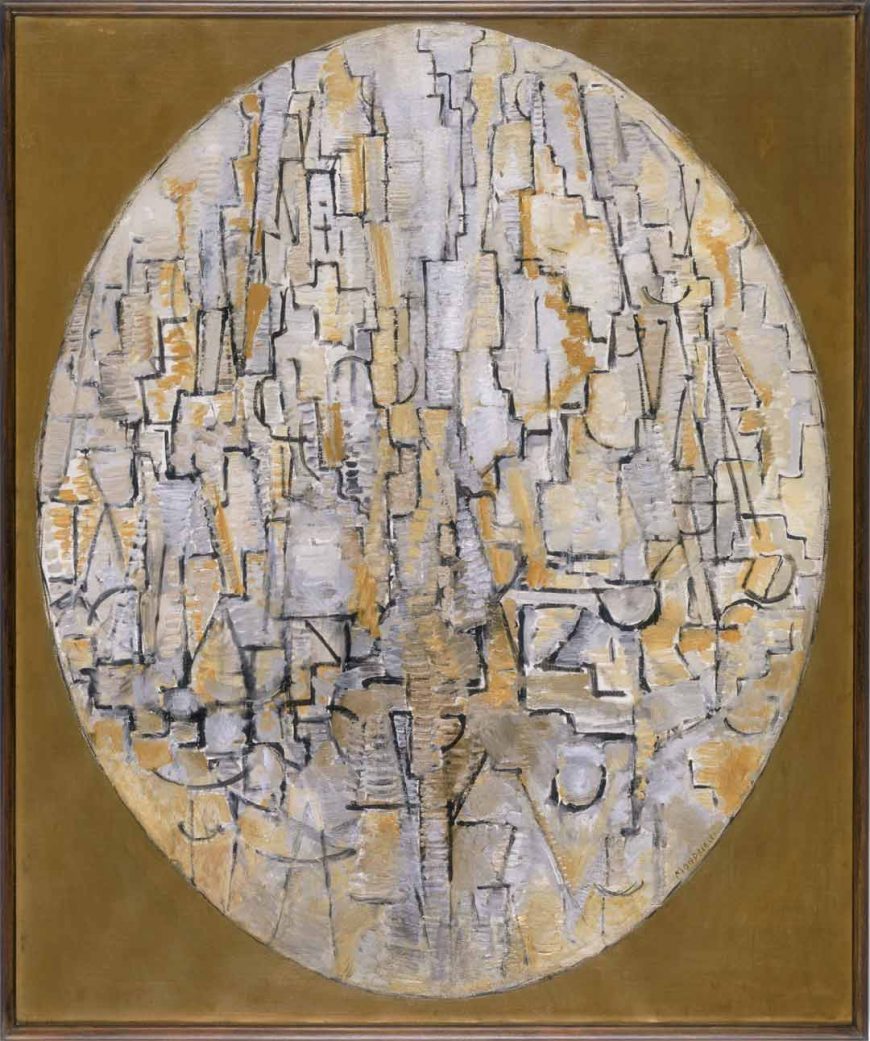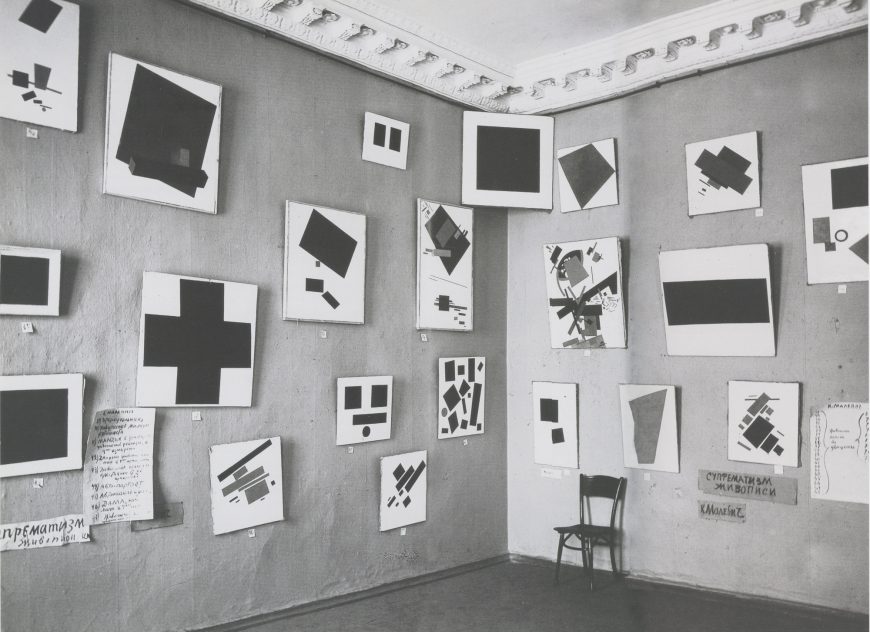Abstract art — also called “non-representational” or “non-objective” — has long been considered a central achievement of modernism. Several early-twentieth century artists claimed to be the first to make a completely abstract artwork, and although it turns out to be surprisingly difficult to fully settle the question, we will consider some of the main contenders below.
Defining the terms
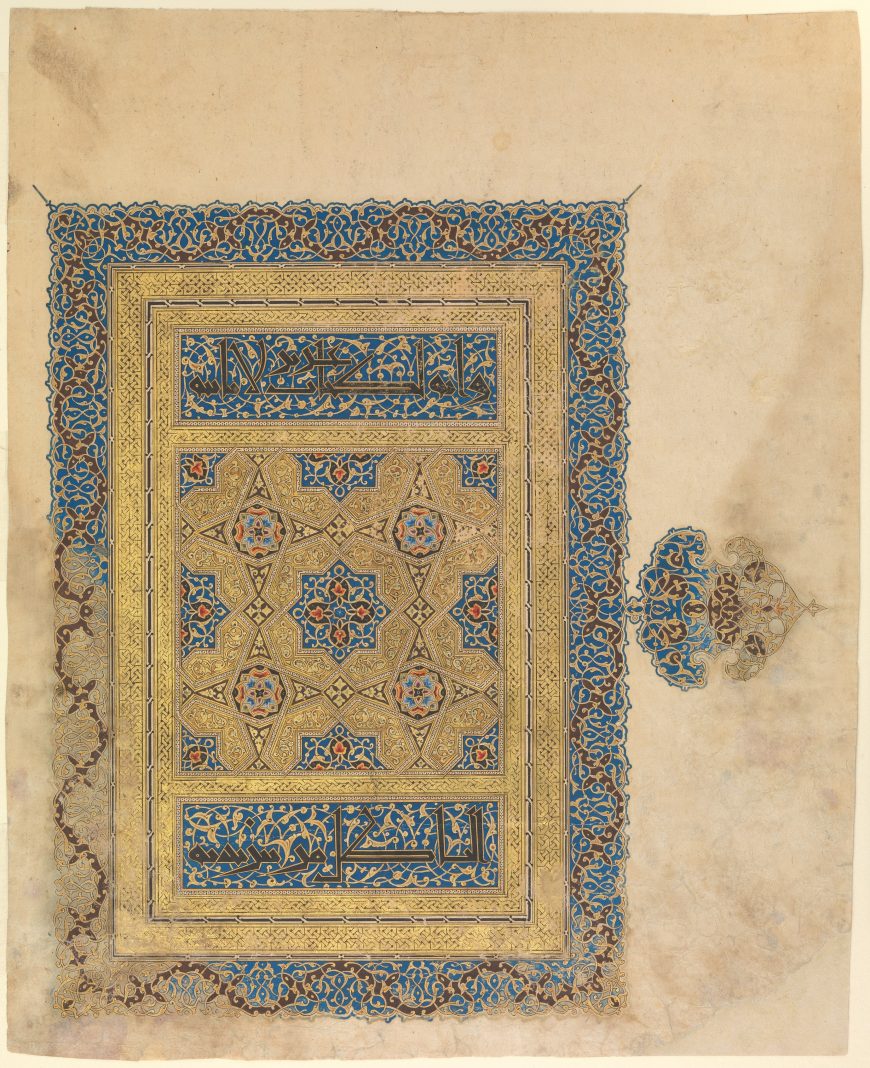
Muhammad ibn Aibak ibn-Abdallah, Folio from a non-illustrated manuscript, 1306-7, ink, opaque watercolor, and gold on paper, 43.2 x 35.2 cm (The Metropolitan Museum of Art)
This 14th-century manuscript painting pre-dates the modern contenders for the first abstract work by over six hundred years. It is one example from a long Islamic tradition of non-representational art. Works like this are generally ignored in discussions about who made the first abstract painting, which reveals that the debate is, in fact, quite limited in its focus. We really mean, “Who in Western culture created the first abstract work?” Like Columbus “discovering” America, it turns out that there were actually a lot of people already there.
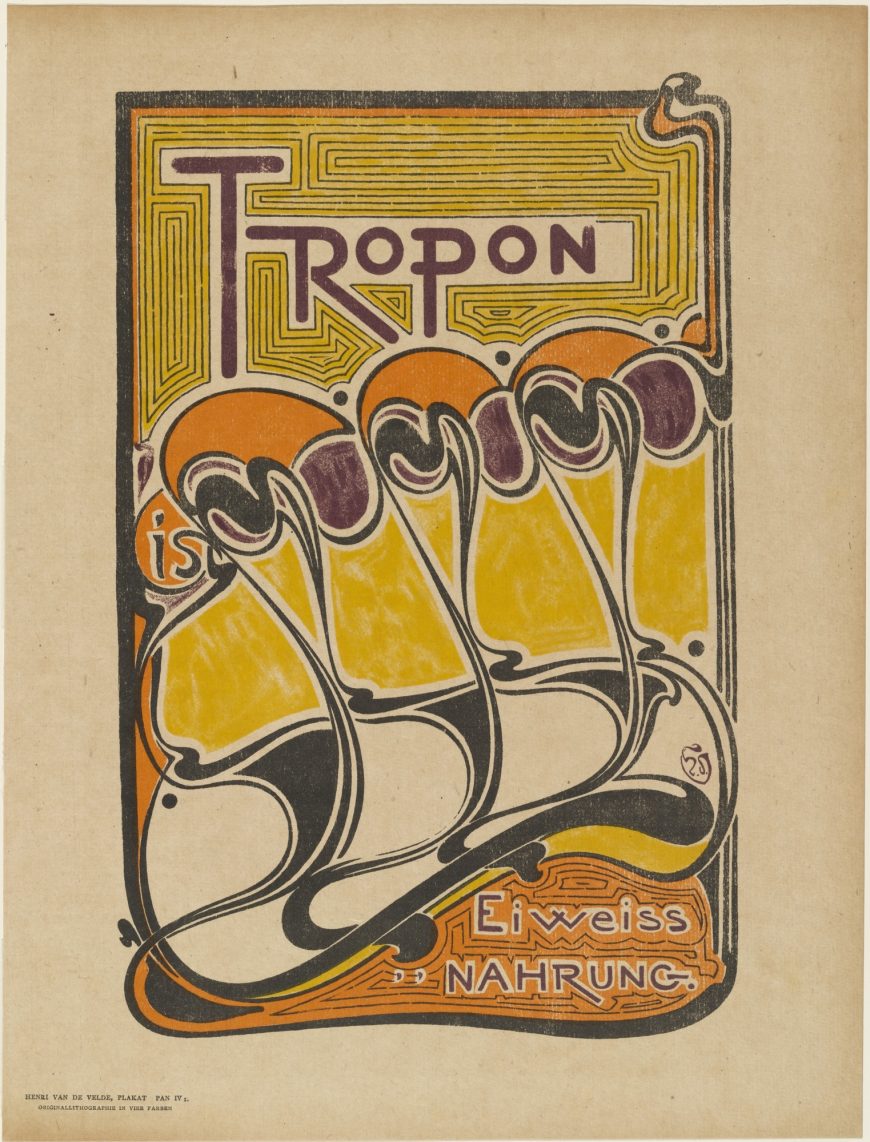
Henri van de Velde, Tropon Poster, from the periodical Pan, vol. IV no. 1 (April-May-June 1898), lithograph, 31.1 x 19.9 cm (MoMA)
Van de Velde’s poster advertising the protein extract Tropon displays an abstract design of stylized, vaguely organic shapes. Why is this also not generally considered a viable contender for the first abstract work? We find that we need to limit the question again: the first abstract work must have been made as “fine art.” Decorative art and commercial design don’t count. This distinction can seem very arbitrary, since many modern artists worked as commercial designers at times, and modern design is also often collected by art museums.
What we are really looking for, then, is not truly “the first” abstract artwork. Instead, we are seeking the first abstract artwork that was intentionally created in the context of the post-Renaissance Western art world, when fine art was expected to be representational.
A De Stijl contender
Piet Mondrian wrote extensive justifications of abstract art, demonstrating a clear awareness of how radical he felt the move to abstraction was for fine art. Over the course of the 1910s he produced several series of works through a process that he explicitly called “abstraction,” etymologically defined as “pulling away” elements of natural appearances from observed objects until eventually they bore no resemblance to those objects.
The work above is part of his series of abstracted trees: perhaps the two parallel vertical lines in the lower center are a trunk, and the oval frame defines the crown of the tree. However, if we approached the work in a museum without that information, it would be easy to see it as abstract in the sense of entirely non-representational. The gradual nature of Mondrian’s evolution makes it very difficult to state when he first created a fully abstract work.
The titling of works can further complicate the issue: this work was titled “Tableau” or “Composition” by Mondrian, asking us to see it as just a composition of lines, shapes, and colors. An equally abstract-seeming work from the same year is called “The Tree A,” which asks us to see a tree where otherwise we might not. Should determining whether a work is abstract depend on its title or other extrinsic information?
Kandinsky’s spiritual vision
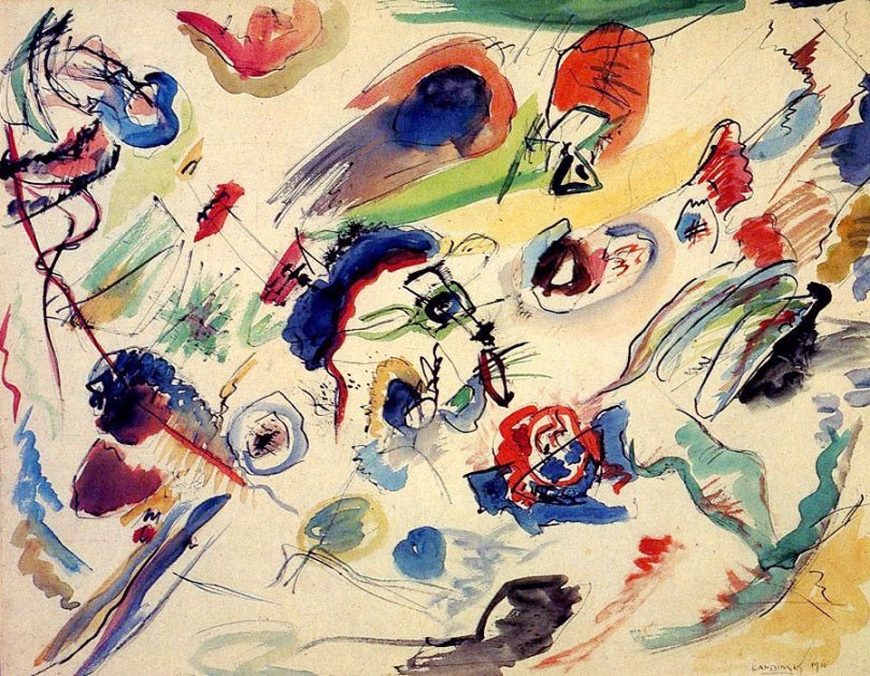
Vasily Kandinsky, Untitled (Study for Composition VII, first abstraction), 1913, watercolor (Centre Pompidou).
Vasily Kandinsky backdated this work to 1910 (in the signature at the lower right), probably in order to claim that he was the first abstract artist — most art historians believe it dates to 1913. His 1909 text On the Spiritual in Art justifies abstraction in art as more spiritual than representation. However he, like Mondrian, approached abstraction very gradually. Even this painting is ambiguously abstract. It is part of a group of works based on imagery of the apocalypse, and, like Mondrian, Kandinsky “abstracted” that imagery to reduce material references.
In many paintings the imagery is very difficult to recognize, but it is still there. Kandinsky famously described seeing one of his own paintings as “only form and colors . . . . whose content was incomprehensible,” but this was only because the work was on its side. Viewing it from the proper angle he saw the painting’s apocalyptic imagery.[1]
Both Mondrian and Kandinsky eventually went on to create unequivocally non-representational artwork, but where is the line between representation and abstraction when the abstracted forms are derived from representational images that only a few people, if any, can recognize? Is abstraction in the eye of the beholder?
Appreciating color and music
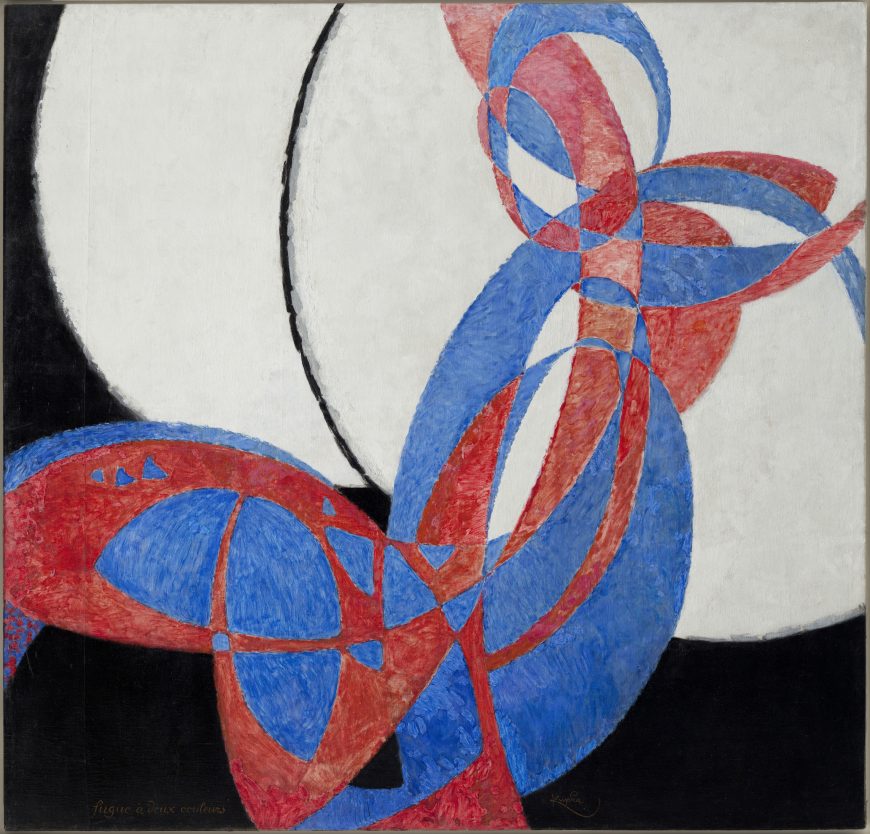
František Kupka, Amorpha, Fugue in Two Colours, 1912, oil, canvas, 211 × 220 cm (National Gallery, Prague)
In the early twentieth century many people (including Kandinsky) justified abstract painting by comparing it to music. When we listen to instrumental music we do not generally compare it to real world sounds; we just enjoy being moved by the melody, harmony, rhythm, etc., in themselves. Why should visual art be different? Why not just appreciate how we are moved by colors, shapes, and textures?
A group of artists called the Orphists, including Robert and Sonia Delaunay and František Kupka, took this route. The title of Kupka’s Fugue in Two Colors declares the painting to be the visual equivalent of a type of musical composition in which a short melody is repeated and developed in multi-part counterpoint. The looping, swelling, intertwining curves of red and blue in Kupka’s painting are understandable as visualizations of the flowing aural interweaving of the musical voices in a fugue. Again, however, there was a naturalistic source for the painting: a drawing of a girl dancing with a ball in her hand that Kupka progressively abstracted.
Malevich’s Suprematism
Kasimir Malevich is unusual in making the leap to pure abstraction very rapidly, rather than through a long process of abstracting natural objects. Malevich’s works in The Last Futurist Exhibition are geometric abstractions, although some of them have titles that suggest real-world references, such as Airplane Flying. Malevich claimed that he first painted a pure abstract work, Black Square, in 1913. However, there is no evidence to support this other than some loosely-related theater designs, and as we have noted, abstraction in design occurred earlier than that. This photograph of the exhibition dates to 1915, and Malevich wrote a theoretical justification of non-representational Suprematist painting the same year, making 1915 a solid terminus ante quem for the first abstract painting.
A new contender
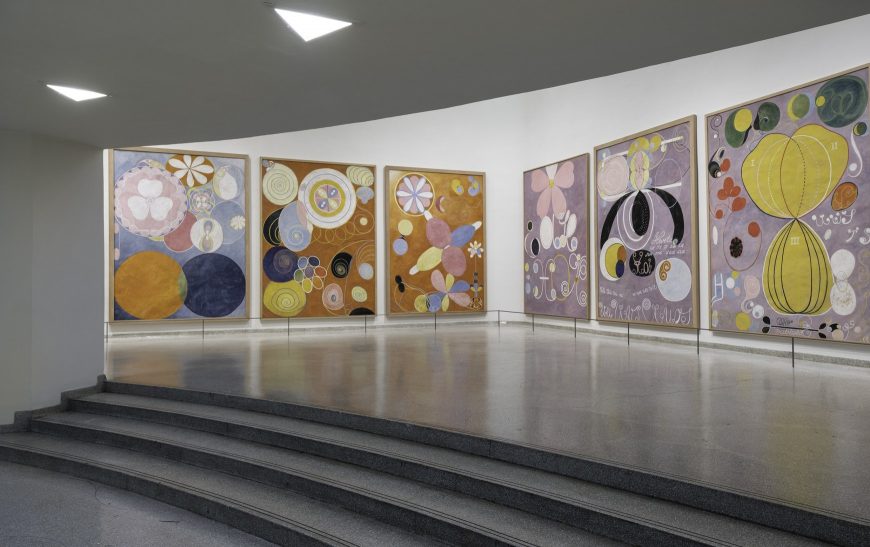
Hilma af Klint, exhibition at the Solomon R. Guggenheim Museum, New York, 2018
Another artist who has recently been brought forward as a candidate for painting the first abstract artwork is Hilma af Klint. Between 1906 and 1915 Klint made a series of works called Paintings for the Temple that were generated from visions she had as a spiritual medium (in fact, all of the artists considered here apart from van de Velde were motivated to create abstract art for spiritual reasons). Some of Klint’s works have recognizable natural imagery, but many others are pure geometric or biomorphic abstractions.
In terms of chronology Klint is a serious contender to be the first abstract painter, and it may be gratifying to think that it is a woman who has that distinction, despite the jockeying of her male contemporaries. Unfortunately, however, Klint’s abstract works were created completely outside the context of the modern art world. In fact, she stipulated that they not be exhibited until twenty years after her death, and as a consequence they were unknown outside of her circle of friends, and had no influence on the debates concerning the viability of abstraction in art until the question was already settled.
An unanswerable question?
In the end, it may not be possible to answer the question of who created the first abstract artwork, but even this brief survey of the main contenders raises an arguably more interesting question. Although there were common themes and some direct contacts between the artists considered here, they were largely independent, working in different countries (Sweden, Russia, Germany, France, and The Netherlands), ending up with very different-looking works, and developing substantially different rationales for practicing abstraction. For whatever reason, in the years around 1910-15 all across Europe, the time was right for abstract art to (re-)enter the Western art world.
Notes:
- Vasily Kandinsky, “Reminiscences” (1913), as translated in Robert L. Herbert, ed., Modern Artists on Art (Mineola, New York: Dover Publications, 2000), p. 29.
Additional resources:

